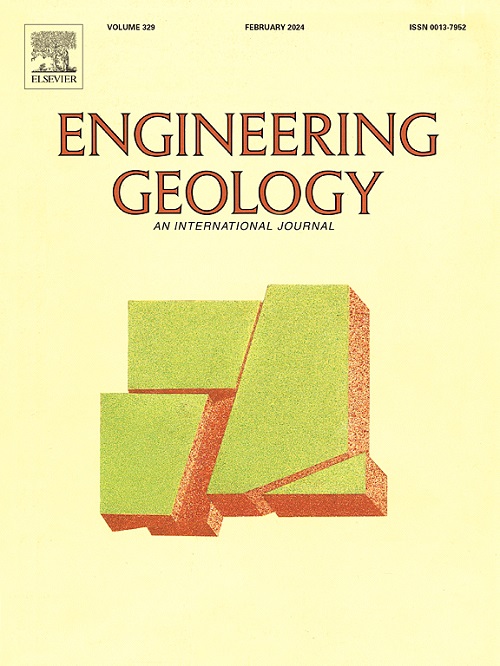考虑孔隙结构和各向异性的油页岩原位转化热-水-机械耦合模型研究
IF 8.4
1区 工程技术
Q1 ENGINEERING, GEOLOGICAL
引用次数: 0
摘要
油页岩的原位转化是一个涉及多个物理场耦合的复杂过程。通过一系列室内实验,揭示了油页岩在加热过程中孔隙结构的各向异性与物理力学性质的各向异性之间的关系。结果表明:在加热过程中,热解诱发的平行层理宏观裂缝显著降低了垂直层理方向的导热系数,显著提高了平行层理方向的渗透率,显著降低了平行层理方向的抗压强度和垂直层理方向的弹性模量;在此基础上,首先建立了油页岩原位转化的热-液-力耦合模型,将各向异性热力损伤与横向各向同性本构模型相结合,研究了油页岩原位转化对流加热过程中储层温度场、渗流场、应力场和位移场的变化规律。研究结果表明:(1)采暖井温度场呈椭圆形扩展向外扩散,在采暖585 d时达到整个油藏的目标温度;(2)渗透率变化具有明显的各向异性,与温度波动密切相关。(3)温度升高会改变孔隙压力的分布,进而影响水蒸气的升温速率。(4)储盖垂向位移变化经历了快速增加阶段、短暂快速减少阶段、过渡阶段和持续减少阶段四个阶段。其中,最大膨胀位移为0.056 m,最大压缩位移为- 0.081 m。本研究不仅为推进油页岩原位转化技术的发展提供了重要的科学理论支持,也为今后油页岩大规模工业化开采提供了可靠的科学依据。本文章由计算机程序翻译,如有差异,请以英文原文为准。
Investigation of thermal-hydraulic-mechanical coupling model for in-situ transformation of oil shale considering pore structure and anisotropy
The in-situ transformation of oil shale is an intricately complex process involving multiple physical field coupling. Through a series of laboratory experiments, this study reveals the relationship between the anisotropy of pore structure and the anisotropy of physical and mechanical properties in oil shale during the heating process. Results reveal that during heating, pyrolysis-induced parallel bedding macroscopic cracks significantly diminish thermal conductivity in the vertical bedding direction, drastically elevate permeability in the parallel bedding direction, and markedly decrease compressive strength in the parallel bedding direction and elastic modulus in the vertical bedding direction. Subsequently, we firstly propose a thermal-hydraulic-mechanical coupling model for the in-situ transformation of oil shale, which integrates anisotropic thermodynamic damage with a transversely isotropic constitutive model, to investigate the variation patterns of the reservoir temperature field, seepage field, stress field and displacement field during the convective heating process for in-situ transformation. Research findings indicate that: (1) the temperature field expands elliptically from the heating well and disseminates outwardly, achieving the target temperature across the entire reservoir by the 585th day of heating. (2) Permeability changes exhibit pronounced anisotropy and are tightly correlated with temperature fluctuations. (3) The distribution of pore pressure undergoes alterations due to temperature increases, which in turn impacts the heating rate of water vapor. (4) The vertical displacement change of the reservoir cap progresses through four distinct stages: a rapid increase phase, a brief rapid decrease phase, a transitional phase and a continuous decrease phase. Notably, the maximum expansion displacement is 0.056 m, while the maximum compression displacement reaches −0.081 m. This research not only provides significant scientific theoretical support for advancing the development of in-situ transformation technology for oil shale, but also offers reliable scientific evidence for large-scale industrial exploitation of oil shale in the future.
求助全文
通过发布文献求助,成功后即可免费获取论文全文。
去求助
来源期刊

Engineering Geology
地学-地球科学综合
CiteScore
13.70
自引率
12.20%
发文量
327
审稿时长
5.6 months
期刊介绍:
Engineering Geology, an international interdisciplinary journal, serves as a bridge between earth sciences and engineering, focusing on geological and geotechnical engineering. It welcomes studies with relevance to engineering, environmental concerns, and safety, catering to engineering geologists with backgrounds in geology or civil/mining engineering. Topics include applied geomorphology, structural geology, geophysics, geochemistry, environmental geology, hydrogeology, land use planning, natural hazards, remote sensing, soil and rock mechanics, and applied geotechnical engineering. The journal provides a platform for research at the intersection of geology and engineering disciplines.
 求助内容:
求助内容: 应助结果提醒方式:
应助结果提醒方式:


